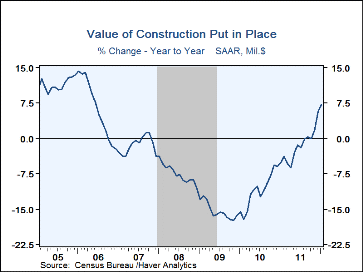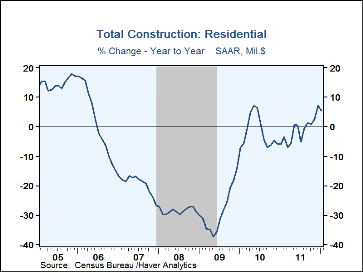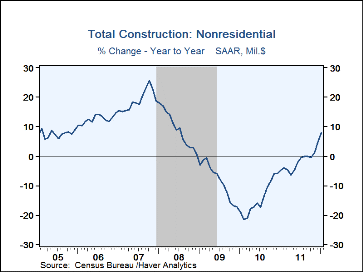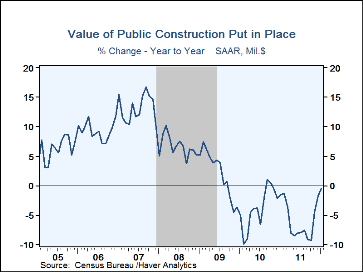 Global| Mar 01 2012
Global| Mar 01 2012U.S. Construction Spending Slips Following Earlier Strength
by:Tom Moeller
|in:Economy in Brief
Summary
After several months of strong increase, construction spending slipped in January. The 0.1% decline followed a 1.4% December rise and a 1.9% November gain that was revised up sharply. Gains in the Summer also were solid. Consensus [...]
After several months of strong increase, construction spending slipped in January. The 0.1% decline followed a 1.4% December rise and a 1.9% November gain that was revised up sharply. Gains in the Summer also were solid. Consensus expectations were for a 0.8% January increase and the level of activity was at its highest since December 2009.
Private sector spending slipped marginally due to a 1.5% decline (+16.6% y/y) in nonresidential building. Residential building rose 1.8% (6.7% y/y) as single-family construction increased 2.5% (5.5% y/y) and multi-family rose 0.7% (20.0% y/y). The value of spending on improvements increased 1.3% (6.4% y/y). The value of public sector building activity slipped 0.2% in January but the y/y decline stabilized at -0.5% following the worst comparison of -8.3% this past Summer.
The construction put-in-place figures are available in Haver's USECON database. The expectations figure is contained in Haver's AS1REPNA database.
| Construction Put in Place (%) | Jan | Dec | Nov | Y/Y | 2011 | 2010 | 2009 |
|---|---|---|---|---|---|---|---|
| Total | -0.1 | 1.4 | 1.9 | 7.1 | -1.7 | -11.3 | -15.3 |
| Private | -0.0 | 1.8 | 1.6 | 11.7 | 1.0 | -15.2 | -22.4 |
| Residential | 1.8 | 1.5 | 2.3 | 6.7 | -0.7 | -2.9 | -29.9 |
| Nonresidential | -1.5 | 2.1 | 1.0 | 16.6 | 2.5 | -24.0 | -16.0 |
| Public | -0.2 | 0.7 | 2.3 | -0.5 | -6.0 | -3.9 | 2.1 |
Tom Moeller
AuthorMore in Author Profile »Prior to joining Haver Analytics in 2000, Mr. Moeller worked as the Economist at Chancellor Capital Management from 1985 to 1999. There, he developed comprehensive economic forecasts and interpreted economic data for equity and fixed income portfolio managers. Also at Chancellor, Mr. Moeller worked as an equity analyst and was responsible for researching and rating companies in the economically sensitive automobile and housing industries for investment in Chancellor’s equity portfolio. Prior to joining Chancellor, Mr. Moeller was an Economist at Citibank from 1979 to 1984. He also analyzed pricing behavior in the metals industry for the Council on Wage and Price Stability in Washington, D.C. In 1999, Mr. Moeller received the award for most accurate forecast from the Forecasters' Club of New York. From 1990 to 1992 he was President of the New York Association for Business Economists. Mr. Moeller earned an M.B.A. in Finance from Fordham University, where he graduated in 1987. He holds a Bachelor of Arts in Economics from George Washington University.










